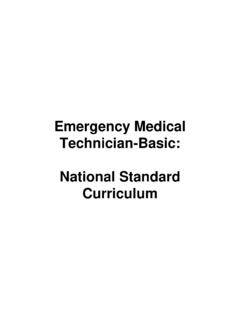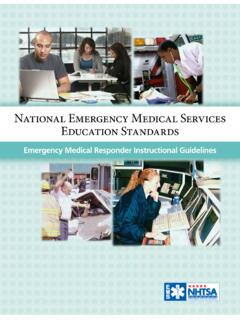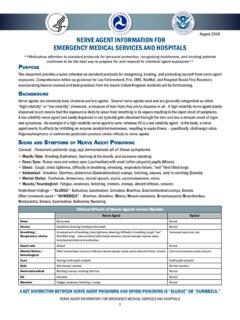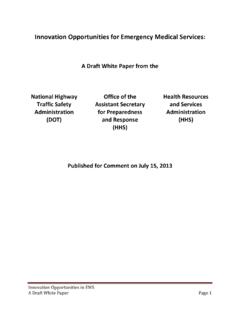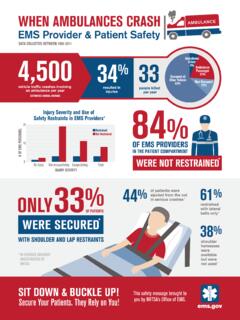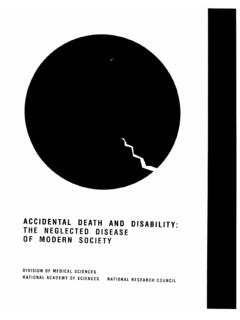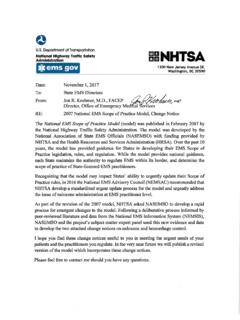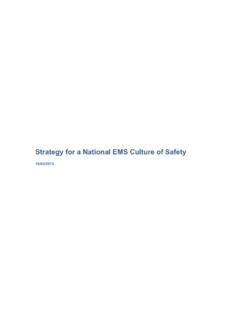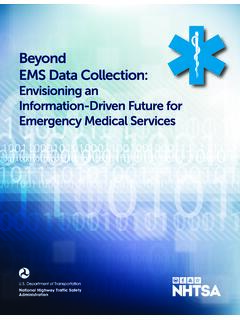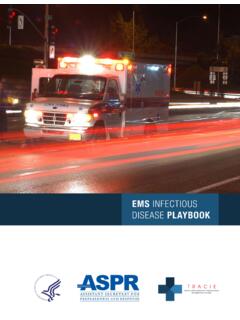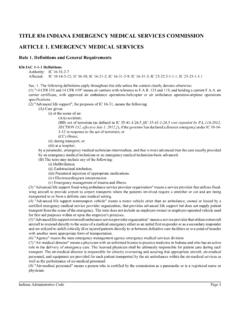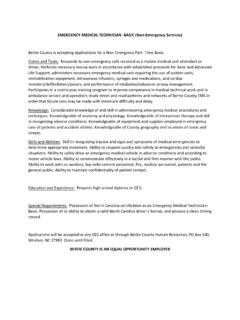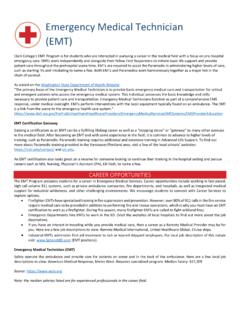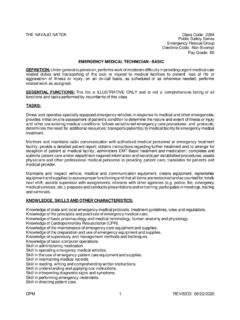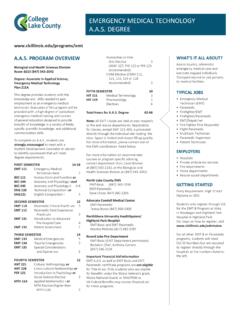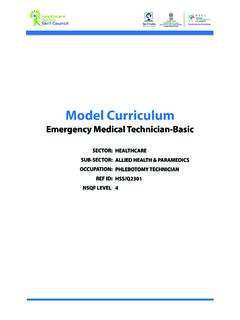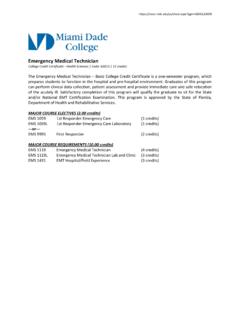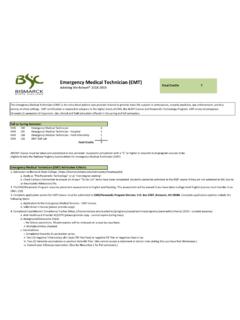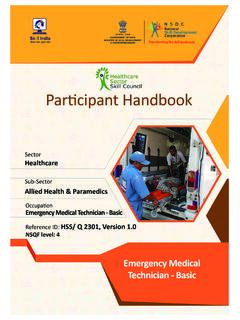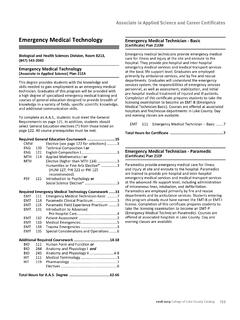Transcription of Emergency Medical Technician: Basic Refresher Curriculum ...
1 Emergency Medical technician : Basic Refresher CurriculumInstructor Course GuideInstructor Course Guide Emergency Medical technician : Basic RefresherTable of ContentsSection/AreaPageIntroduction ---------------------------------------- ---------------------------------- iCourse Overview ---------------------------------------- --------------------------- iiCourse Planning Considerations ---------------------------------------- ------ vCourse Conduct and Evaluation ---------------------------------------- ------- viiiTesting and Evaluating the Student ---------------------------------------- -- xProgram Evaluation ---------------------------------------- ----------------------- xiAcknowledgment ---------------------------------------- --------------------------- xiiiModule I, Preparatory ---------------------------------------- --------------------- I - 1 Module II.
2 Airway ---------------------------------------- --------------------------- II - 1 Module III, Patient Assessment ---------------------------------------- -------- III - 1 Module IV, Medical /Behavioral ---------------------------------------- --------- IV -1 Module V, Trauma ---------------------------------------- ------------------------- V - 1 Module VI, Obstetrics, Infants, and Children ------------------------------- VI -1 Appendix A, USDOT Curriculum Objectives EMT- Basic ---------------- A - 1 Instructor Course Guide Emergency Medical technician : Basic RefresheriINTRODUCTIONHISTORICAL PERSPECTIVEIn 1994 the Department of Transportation s, National Highway Traffic SafetyAdministration completed an extensive revision of the national standard EMT- Basic Curriculum . The Curriculum received national EMS community andphysician review and input during development and resulted in additional skillsand knowledge being available to Emergency Medical Technicians.
3 Thecurriculum was widely accepted and implementation was scheduled throughoutthe 1995 the National Registry of Emergency Medical Technicians funded anational project to develop a transition program for currently certified andlicensed EMT- basics that were educated based upon the 1984 USDOT EMT-Ambulance Curriculum . A committee comprised of the National Council of StateEMS Training Coordinators, the National Association of State EMS Directors, theNational Association of EMS Physicians, the American College of EmergencyPhysicians and the National Registry of Emergency Medical Technicians,approved and disseminated a transition program. The programs goal was tobring all EMT- basics within the nation to the same level of competency over thenew skills and knowledge presented in the 1994 USDOT EMT- Basic 1995 the National Registry of EMTs was asked by the National Council ofState EMS Training Coordinators and the National Association of State EMSD irectors to expand the role of the transition program, fund and develop anational standard EMT- Basic education program based upon the content of the1994 EMT- Basic Curriculum .
4 The independent transition committee acceptedthe responsibility to develop, review and seek input on a Refresher US Department of Transportation, National Highway Traffic SafetyAdministration, in a true public/private partnership agreement, agreed to acceptand publish this Refresher Curriculum after consensus was achieved by thecommittee and the EMT is responsible for a wide range of knowledge and skills which includesmaterial originally learned, as well as new information resulting from the constantgrowth and evolution of the field of Emergency Medical care. In order tomaintain up-to-date proficiency, an EMT must regularly participate in educationalprograms which review the essential components of the national standardcurriculum (NSC) as well as those which provide exposure to new knowledgeand skills resulting from advances in Emergency Medical document is a course guide for the Basic EMT Refresher training program.
5 Itwill provide information which will help program administrators and instructorsInstructor Course Guide Emergency Medical technician : Basic Refresheriiplan and implement a course. The companion lesson plans contain the essentialcomponents of the NSC in a format which may be adapted to a variety ofpresentation schedules, formats and OVERVIEWORGANIZATIONThe EMT- Basic Refresher Curriculum is the minimum acceptable content thatmust be included in any EMT- Basic Refresher educational program. This programshould consist of a minimum of 24 classroom hours. The Refresher trainingprogram is divided into six modules. This organizational plan was chosen tobegin a process of standardization among National Standard six modules , Infants and ChildrenThis Refresher course is competency based.
6 Specific number of hours tocomplete each module have not been included. EMTs who successfullycomplete this course must demonstrate competency over the knowledge andskills outlined in this Refresher education first part of each module lists the specific patient care task in a bold facefont. Immediately below the listed task is the cognitive learning objectives whichcorrespond to the specific task. The list of tasks indicates the minimum level ofproficiency required of the EMT- Basic to assure safe and effective practice. Thepsychomotor and affective objectives relate to the overall content of the PLANSThe Instructor Lesson Plans are designed to provide the technically competentinstructor with the educational materials needed to conduct EMT refreshertraining programs. The 1994 USDOT EMT- Basic National Standard Curriculumshould serve as the reference and minimal supplemental material for eachlesson.
7 Each lesson has the following components:OBJECTIVESThe objectives are divided into three categories: Cognitive, Affective andPsychomotor. To assist with the design and development of a specific lesson,each objective has a numerical value. This numerical value follows the sameInstructor Course Guide Emergency Medical technician : Basic Refresheriiiobjective numbering system presented in the EMT- Basic National -- Each lesson has a motivational statement that should be read bythe instructor prior to teaching the lesson. It is not the intent for the instructor tonecessarily read the motivational statement to the students, but more importantlyto be familiar with its intent and to be able to prepare the students or explain whythis is important to Visual (AV) Equipment -- In recent years the design and development ofhigh quality video has become available for the EMS community.
8 They shouldbe used as an integral part of the instruction in this program. The courseadministrator should assure that the necessary types of AV equipment areaccessible to the class. If possible, the course administrator should have a videolibrary Medical Services (EMS) Equipment -- Each lesson plan containsa list of equipment that should be Instructor -- Each lesson plan clearly defines the necessaryqualifications of the primary Instructor -- Each lesson plan clearly defines the necessaryqualifications of the assistant (What) -- This is the cognitive lesson plan. This is the informationthat the instructor provides. This may be accomplished by various methods,including lectures, small group discussion, and the use of audio-visual , if the instructor desires, may be used as part of the instructor must be well versed with the entire content of the lesson lesson plans are not to be read word for word.
9 Lesson plans should beconsidered dynamic documents that provide guidelines for the appropriate flowof information. The lesson plans are based upon the content of the EMT-BasicNational Standard Curriculum . The instructor should feel free to write notes inthe margins and make the lesson plan their Course Guide Emergency Medical technician : Basic RefresherivProcedural (How) -- This is the skills portion of the program. EMT-Basicsshould be able to demonstrate competency in all skills listed in each section. Ifthe declarative (what) content was presented as a lecture, the instructor mustperform demonstrations prior to having the EMT- Basic perform the skills. If theinstructor performed a demonstration as part of the declarative component, theEMT- Basic may begin by practicing skills in the practical this component of the lesson is being conducted the instructor/EMT ratioshould be no more than 1 to 6.
10 EMT- basics should be praised for their those EMT- basics having difficulty performing a skill or skills, remediation isrequired. It is well known that a demonstration must be followed by practice,which must be drilled to a level that assures mastery of the skill. It has beenproven that demonstration followed as soon as possible with organized,supervised practice enhances mastery and successful (When, Where and Why) -- This section is designed to help EMT- basics understand the application of their knowledge and skills as they relate totheir performance as an EMT- Basic . This section relates back to themotivational statement and represents the reasoning as to why, where and whenthe EMT- Basic would need to use the knowledge or perform the skills. It is ofutmost importance that the instructor be familiar with the intent of this sectionand relay that intent to the Participant Activities -- EMT- basics learn by various methods.
